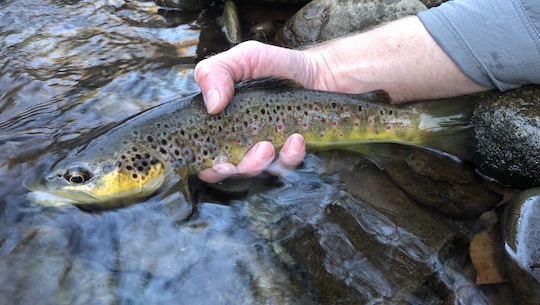No, I'm not talking about nighttime fishing, although I have covered that topic some before and found great success fishing through the night. In this instance, I'm actually referring to the late afternoon and early evening hours on bright sunny days. As the sun sinks below hills and ridges, fish that were almost impossibly shy just minutes earlier begin to feed.
Interestingly, this is not always consistent, but when it happens the results are striking. The difficulty of bright sunny days is exacerbated in the Smokies in particular early and late in the season. This is due to the lack of leaves on the trees. This year, we lost all of the leaves earlier than has been usual the last few seasons. Thus, we have been dealing with bright sunny days since the last week of October. Last year, I was still enjoying a reasonably decent canopy on Veteran's Day week for my annual fall camping trip. For this year's camping trip, the leaves were all down.
I drove over to the Smokies on Wednesday to camp and fish the Oconaluftee River with my buddy and fellow fly fishing guide, Pat Tully. We had a great time fishing, but the catching was slow. This isn't entirely unheard of this time of year, but the super low water from our recent drought conditions along with the sunny day was making things more difficult than usual for fall fishing. Eventually, Pat had to leave to make it back home at a reasonable hour.
Since I was spending the night at Smokemont campground, I headed over to set up camp. By the time this task was finished, the sun was beginning to sink below the hills above camp. This time of year that happens early each day. I had enjoyed a late lunch, so instead of proceeding to supper, I decided to get back on the water for another couple of hours. That proved to be a great decision.
In the first small run I fished, I had numerous strikes on a small parachute Adams. Best of all, the fish were hitting it within just a few feet of where I was standing. They weren't spooky any more. As I always like to say, fish have to eat eventually. I was about to be rewarded for hanging in there after a long tough day.
Over the next hour or two, I caught double digit numbers of trout. Two were very nice brown trout for in the Smokies while the majority were rainbows. Often, I was catching what was probably the "best" rainbow trout in each little run and pocket. These fish would have run from their own shadow just hours before. Now, they needed to get those calories in. Winter is coming soon after all.
By the time I decided to call it an evening, I had caught more than enough fish to make up for the slow day. As I headed back to camp, I was reminded why it is worth fishing as long as possible. On some days, responsibilities back home or otherwise mean I quit before the end of legal fishing hours. In fact, it is rare that I have the luxury of fishing as long as I want. Still, it is always good to be reminded to keep after it even when I'm having a difficult day.
And isn't that what drives us on as anglers? The chance of a new superlative, be it a monster fish, a big numbers day, or maybe just an incredibly unique experience on the water. Perhaps a particular hatch keeps bringing you back or even a particular fish.
I have a brown trout on Little River that I've been keeping tabs on for about a month now. It is built like a torpedo. A super fat torpedo. I'm still not certain it would break 20", but it will be extremely heavy for its size if I can ever get my hands on it, that I'm convinced of. When I go after it again, I'll stay out as long as possible, hopefully after the sun goes down behind the nearby ridge...





